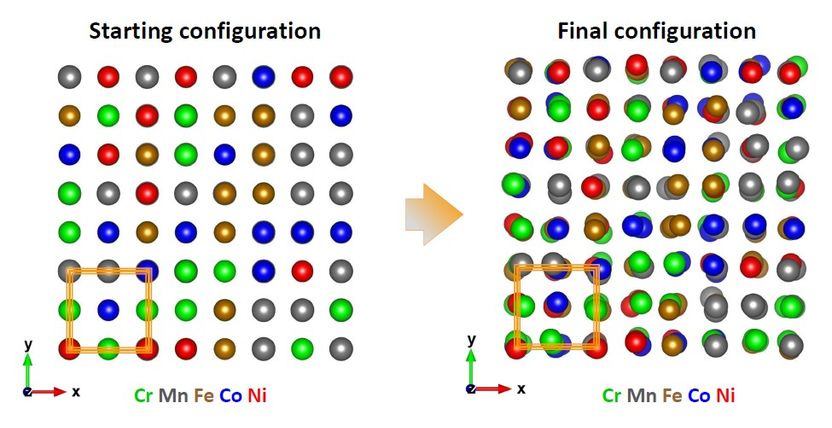Atomic displacements in High-Entropy Alloys examined
High-entropy alloys are under discussion for very different applications
Advertisement
High-entropy alloys of 3d metals have intriguing properties that are interesting for applications in the energy sector. An international team at BESSY II has now investigated the local order on an atomic scale in a so-called high-entropy Cantor alloy of chromium, manganese, iron, cobalt and nickel. The results from combined spectroscopic studies and statistical simulations expand the understanding of this group of materials.

The supercell is randomly filled with the five elements on the fcc-lattice positions; In the starting configuration, all layers are precisely on top of each other. The displacements of all elements in the final configuration have been revealed by a simultaneous fit of the independent experimental spectra with a use of Reverse Monte Carlo simulations.
© A.Kuzmin / University of Latvia and A. Smekhova / HZB
High-entropy alloys are under discussion for very different applications: Some materials from this group are suitable for hydrogen storage, others for noble metal-free electrocatalysis, radiation shielding or as supercapacitors.
The microscopic structure of high-entropy alloys is very diverse and changeable; in particular, the local ordering and the presence of different secondary phases affect significantly the macroscopic properties such as hardness, corrosion resistance and also magnetism. The so-called Cantor alloy, which consists of the elements chromium, manganese, iron, cobalt and nickel mixed in an equimolar proportion, can be considered as a suitable model system for the whole class of these materials.
Local structure studied at BESSY II
Scientists from the Federal Institute for Materials Research (BAM, Berlin), the University of Latvia in Riga, Latvia, the Ruhr University in Bochum and the HZB have now studied the local structure of this model system in detail. Using X-ray absorption spectroscopy (EXAFS) at BESSY II, they were able to precisely track each individual element and their displacements from the ideal lattice positions for this system in the most unbiased manner with the help of statistical calculations and the reverse Monte Carlo method.
Chromium shows larger displacements
In this way, they uncovered peculiarities in the local environment of each element: Despite all five elements of the alloy are distributed at the nodes of the face-centred cubic lattice and have very close statistically averaged interatomic distances (2.54 - 2.55 Å) with their nearest neighbours, larger structural relaxations were found solely for chromium atoms. Besides, no evidence of secondary phases was detected at the atomic scale. The macroscopic magnetic properties studied with conventional magnetometry at HZB CoreLab were correlated with the revealed structural relaxations of Chromium.
"The results describe the arrangement of individual atoms at the atomic scale and how the complex magnetic order that we revealed may occur," explains HZB physicist Dr. Alevtina Smekhova, who supervised the experiments at HZB.
Original publication
Other news from the department science
Most read news
More news from our other portals
See the theme worlds for related content
Topic World Spectroscopy
Investigation with spectroscopy gives us unique insights into the composition and structure of materials. From UV-Vis spectroscopy to infrared and Raman spectroscopy to fluorescence and atomic absorption spectroscopy, spectroscopy offers us a wide range of analytical techniques to precisely characterize substances. Immerse yourself in the fascinating world of spectroscopy!

Topic World Spectroscopy
Investigation with spectroscopy gives us unique insights into the composition and structure of materials. From UV-Vis spectroscopy to infrared and Raman spectroscopy to fluorescence and atomic absorption spectroscopy, spectroscopy offers us a wide range of analytical techniques to precisely characterize substances. Immerse yourself in the fascinating world of spectroscopy!



























































